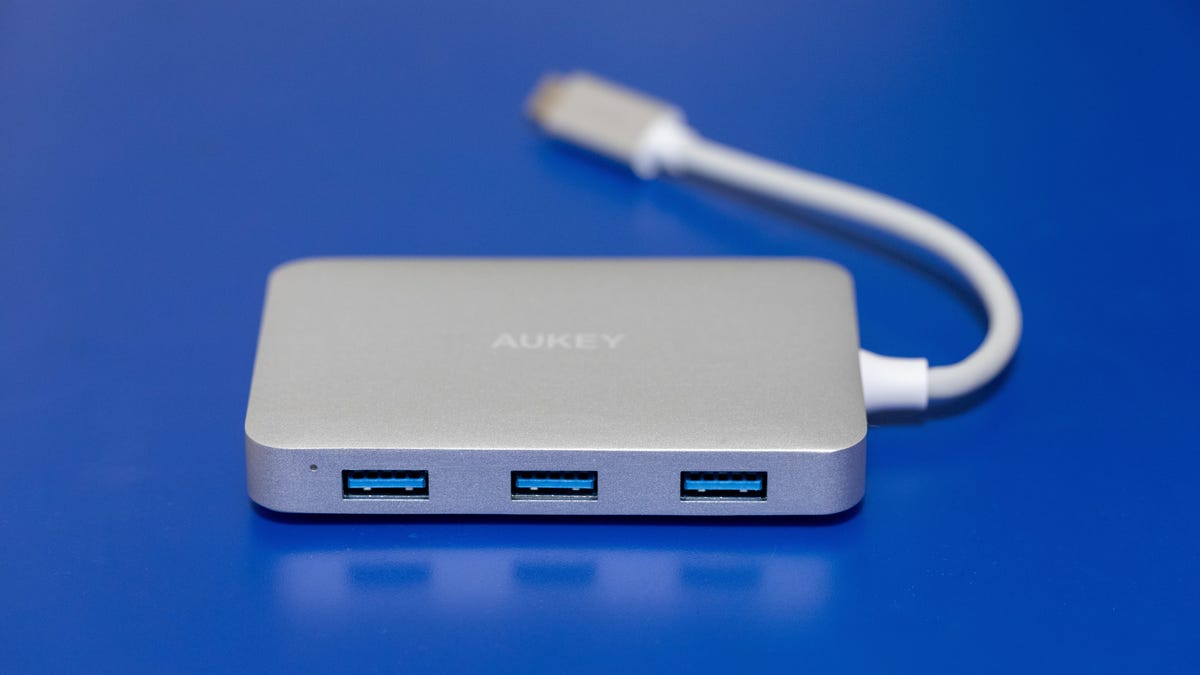USB 4 will resurrect those ever-so-useful USB hubs
Laptops don't have as many ports with the USB-C revolution, but better dongles will come to the rescue.

USB hubs are fine today -- as long as you only need old-style USB-A ports like on this Aukey model. USB 4 should allow lots of the more modern USB-C ports.
The upcoming USB 4 will restore a useful feature we lost with the technology's modernization: USB hubs that let you multiply the utility of a single port on your PC.
USB, short for Universal Serial Bus, is a remarkably successful standard more than two decades old now. It's spread far and wide, but the newer USB-C technology doesn't work well for one pretty ordinary gadget, a USB hub. These hubs have a cable at one end that plugs into your computer and a number of USB ports to accommodate multiple devices -- a keyboard, mouse, network adapter and memory stick, for example.
USB 4, under development now and due to arrive in products in 2020, should fix that shortcoming, says Ben Hacker, director of USB strategic planning at Intel. He points to USB 4's incorporation of Intel's Thunderbolt technology, a fast though expensive alternative to USB.
"What USB-C was trying to do is become that one [PC and phone] connector to rule them all. It's not quite there," Hacker said at an Intel event Monday. "Our contribution helps it get closer to that."
It's an important, if seemingly minor, change because USB-C's new usefulness has ironically left many of us short of USB ports.
USB-C is good enough that it can replace many ports, including those for power, video, audio and the old-style USB-A ports that laptops have used for years. That means laptop makers can consolidate ports. Apple's MacBooks have just one, for example, and its MacBook Airs have two. That makes USB hubs really useful.
USB upgrade victim
USB is in the midst of massive modernization. Most visible is the shift to the physical USB-C connector now common on laptops, Android phones and the new iPad Pro. USB-C cables are conveniently reversible so you don't have to figure out which side is up when plugging them in.
But there are lots of other changes, too. A series of speed boosts arrived: USB 3.0 at 5 gigabits per second, USB 3.1 at 10Gbps and the new USB 3.2 at 20Gbps. USB now can charge laptops and countless other devices with USB Power Delivery technology. And "alt modes," which let you connect monitors with HDMI and DisplayPort video standards the cable connect to HDMI, gives USB-C ports even more options.
Intel's Thunderbolt today lets different types of data share the same wires, a technology that should help USB 4's flexibility in 2020.
The flexibility of those alt modes means it's hard to know exactly what type of data is flowing across USB-C wires, though, and that in turn hampered USB-C hubs, Hacker said.
Thunderbolt works differently. Controller chips at each end of the connection handle a variety of data types, stuff them onto the wires at an even faster 40Gbps transfer rate, then detangle all the data at the other end of the connection. USB 4 is being rebuilt with that technology, which Intel released royalty-free after years of largely unsuccessful efforts to push Thunderbolt as mainstream technology.
"It's very fast relative to current USB," Hacker said. "It's designed to traverse hubs or daisy chains," where data hops from device to device along a chain of cables.
Thunderbolt will get a boost as new chips from Intel build the technology in directly so an extra chip isn't required. But USB's incorporation of Thunderbolt leaves the technology's future uncertain. Asked what value it offers, Hacker said Thunderbolt lets people use USB-C without fear of possible problems like cables that are slow or can't handle enough charging power.
"It's to signal a best-in-class USB-C implementation," he said of the Thunderbolt name.
Getting data from point A to point B
Hacker described the improvement at an event called Interconnect Day focusing on one of Intel's six pillars of crucial technology. The other five pillars are manufacturing processes, chip architecture, memory, security and software. Improving interconnect technology and standards is crucial to computing performance since interconnects get data from where it's stored to where it's needed.
Over the last 12 years, interconnect speeds have improved exponentially from the shortest data-transfer distances to the longest.
At its event Intel showcased a range of developments. Among them:
- Intel's Compute Express Link (CXL) technology, which it hopes will make it easier to shuttle computing jobs from CPUs to graphics chips and other accelerator chips.
- A new 800 series of Ethernet network cards for servers using technology called application device queues that transfers data at more reliably fast speeds.
- New silicon photonics technology that glues lasers to chips for faster fiber-optic networking. A new adapter due this year will be able to communicate at speeds of 400Gbps over long distances.
Interconnect technology covers everything from communications from one side of a chip to the other to data links across the entire planet, said Jim Keller, the senior vice president in charge of Intel's silicon engineering work.
"That's a pretty big range," he said. "The distance varies by a factor of a billion."

